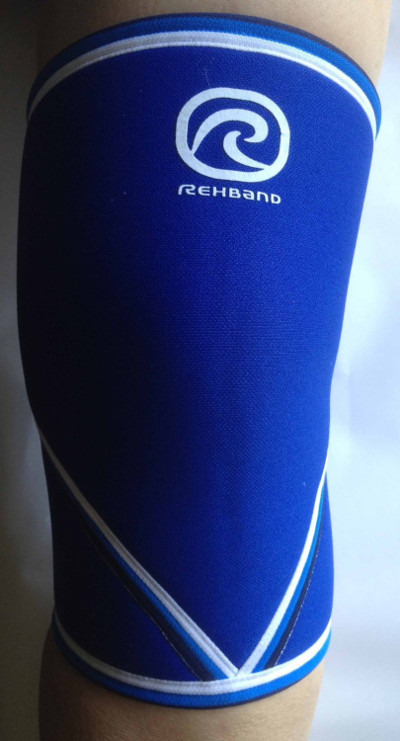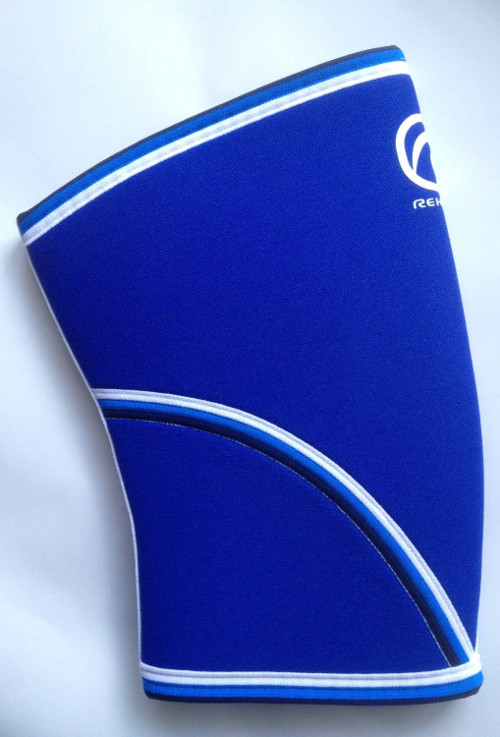So why Knee Sleeve? As with any athletic activity, you must take care of your body so that it takes care of you. Two of the most important parts of the body to keep healthy and avoid the trials of nagging injury are the knees and the back.
For those with back trouble, they should wear a lifting belt. Not everyone needs to wear one, but anyone who has previously suffered a sprain or strain (which is the vast majority of lifters) should consider using a weight belt.
The case is exactly the same for knee sleeves. Olympic weightlifting puts a tremendous strain on delicate tendons and joints, and this is especially true of the knees (in addition to the elbows and shoulders of course 🙂 ).
Materials, Design and Features of a Quality Knee Sleeve
Knee sleeves are typically made out of neoprene, which is a resilient, synthetic rubber made through a process using polymers. But unlike a slim weight belt that only adds some support around the trunk, a knee sleeve envelops the entire knee to help ensure stability in the joint and ward off bad mechanics. A knee sleeve will also keep the muscles and tendons in the area warm, so they will be less stiff and therefore less susceptible to injury.
Of course, knee sleeves also hinder a lifter’s range of movement, so some lifters prefer to go without them. Additionally, knee sleeves do not need to be worn for all lifting exercises, but they can be especially handy when doing squats of any kind. Which is perfect for Olympic lifters because they deliver the support you need when performing the snatch or clean and Jerk.
Because the knees take such a pounding during everyone’s daily routine, exercise and exertion at the gym can manifest injuries that have been developing. People who jog may not necessarily sustain an injury while jogging, but they will notice it upon going out for a run.
Knee Injuries you must Avoid
In the course of weightlifting workouts, the biggest worry about the knee is developing patellar tendinitis. This injury is common in other sports that involve a lot of jumping, like basketball or volleyball. But weightlifters put a tremendous amount of strain on the knees, and particularly the kneecaps.
The force involved in lifting that much mass actually grinds the kneecap onto itself, producing a progressive tendonitis. Aside for making sure not to lift too much weight to quickly, it’s important to rest up and avoid certain parts of your workout that leaves you with acute pain afterwards.
When the knee has been weakened, that is when it is vulnerable and prone to worsening injury. If you don’t feel sharp pain, but more of an ache, a knee sleeve can provide the necessary support to get you through a safe and productive workout. Once the knee heals, you can lift without the knee sleeve if you choose, but it helps to have the option of support at your disposal.
Rehband knee Sleeves
The original blue Rehband knee sleeves became a signature on the knees of strongmen from a whole host of nations, and this classic comes in as our top pick for knee sleeves. They offer a trusted name brand as well as a solid background in manufacturing the equipment. As always, ensure the product you choose if comfortable and supportive, and you will want to seek out competitive pricing and options made by other suppliers, but it’s hard to go wrong with big blue from Rehband. If you don’t have a pair get it NOW, they’re the standard for a reason !!
In our next article we look at The Importance of Lifting Chalk. Thanks for visiting www.olympicweightsetreview.com, if you liked this article please use our social buttons to give us the thumbs up.
[hr]
Related Post
[related_posts limit=”3″]

